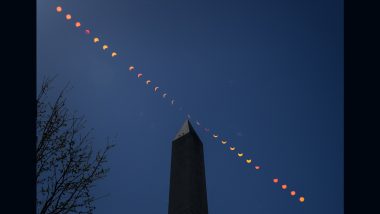New York, April 9: Millions of people across parts of Mexico, Canada, and the United States watched the rare total solar eclipse on Monday. The path of totality, a tiny area where the Moon completely obscures the Sun, crossed across cities and sent the United States into a frenzy. NASA has shared the captivating live stream on its official broadcast channel on YouTube to witness the solar eclipse. For the first time in nearly a century, the western and northern regions of New York State saw a total eclipse.
The Mexican beachside resort town of Mazatlan was the first major viewing spot in North America. The partial eclipse began in southern Texas near Eagle Pass on the southern border with Mexico, marking the start of the eclipse in the United States. The total solar eclipse of 2024 was the historic celestial event because it won't be visible across the contiguous US again until August 2044 and an annular eclipse -- which happens when the moon can't completely block the sun-- won't appear across this part of the world again until 2046. Solar Eclipse 2024 Photos and Videos: Total Eclipse Observed in Different Parts Across World, Residents Share Glimpses of Spectacular Celestial Event.
Earlier, CNN reported, Mexico's Pacific coast is the first point of totality on the path, expected at 11:07 am local time (2:07 pm ET), and the eclipse is expected to end on the Atlantic coast of Newfoundland at 5:16 pm local time (3:46 pm ET). Emphasising safety while watching the total solar eclipse, earlier NASA shared a post on X, stating, "We want you to watch the total solar #eclipse. We just don't want it to be the last thing you see." NASA stressed that it is not safe to look directly at the Sun without specialized eye protection for solar viewing.
Total Solar Eclipse
Follow, follow the Sun / And which way the wind blows / When this day is done 🎶
Today, April 8, 2024, the last total solar #eclipse until 2045 crossed North America. pic.twitter.com/YH618LeK1j
— NASA (@NASA) April 8, 2024
Total Solar Eclipse Seen From Carbondale, Illinois
#WATCH | Illinois, US: Total Solar eclipse as seen from Carbondale of US' Illinois state.#TotalSolarEclipse2024
(Source: NASA) pic.twitter.com/LPMs6ZlVQA
— ANI (@ANI) April 8, 2024
Total Solar Eclipse Seen From Houlton, Maine
#WATCH | Houlton, Maine: Total Solar eclipse seen in Houlton city of US' Maine state. #TotalSolarEclipse2024
(Source: NASA) pic.twitter.com/Gd4eZRC9XH
— ANI (@ANI) April 8, 2024
"Except during the brief total phase of a total solar eclipse, when the Moon completely blocks the Sun's bright face, it is not safe to look directly at the Sun without specialized eye protection for solar viewing," it said. It further stated that viewing any part of the bright Sun through a camera lens, binoculars, or a telescope without a special-purpose solar filter secured over the front of the optics will instantly cause severe eye injury. "When watching the partial phases of the solar eclipse directly with your eyes, which happens before and after totality, you must look through safe solar viewing glasses ("eclipse glasses") or a safe handheld solar viewer at all times. First Total Solar Eclipse Photo Ever! Stunning Picture of Surya Grahan Captured by Prussian Photographer Johann Julius Friedrich Berkowski in 1851 Surfaces (See Pic).
Eclipse glasses are NOT regular sunglasses; regular sunglasses, no matter how dark, are not safe for viewing the Sun," it added. NASA emphasised that the concentrated solar rays will burn through the filter and cause serious eye injury, adding, "Do NOT look at the Sun through a camera lens, telescope, binoculars, or any other optical device while wearing eclipse glasses or using a handheld solar viewer." Moreover, one of the amazing side-effects of the eclipse is its ability to change the weather -- but it has its limits, reported CNN.
Changes to temperature, wind speed and humidity occur as the moon crosses in front of the Sun and casts a shadow on Earth's surface during a solar eclipse. In the path of totality, temperatures drop by around 10 degrees, additionally, it also start to feel more humid and winds and cloud coverage could drop. Scientists understand the concept of how solar material flows from the sun in a better way by observing the sun during eclipses, according to CNN. Charged particles known as plasma create space weather that interacts with an upper layer of Earth's atmosphere, called the ionosphere. Many low-Earth orbit satellites and radio waves operate in the ionosphere, which means dynamic space weather has an impact on GPS and long-distance radio communications.
(This is an unedited and auto-generated story from Syndicated News feed, LatestLY Staff may not have modified or edited the content body)













 Quickly
Quickly




















